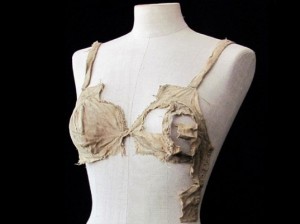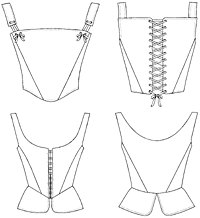When asked what makes a lady feel especially feminine, many will respond having the right undergarments. Even if no one else sees them, there is something about wearing pretty lace which accents the natural beauty of the female form, which gives an extra inner confidence to its wearer. This is true for panties, garters, bustiers, or bras.
It had befuddled me for some time why starlets of the last century were able to have such large busts and hips, while having the most minimal waists imaginable. This was even more noticeable during the Victorian era. In one of the Little House books, by Laura Ingalls Wilder, it is noted that Ma had such a tiny waist when she got married that Pa was easily able to encircle his hands around it.
It is difficult to pinpoint exactly how long women’s undergarments have been around. Cloth is a material which eventually does degrade. Long before the modern archaeologist is able to find these items, the evidence of many would-be garments has become nothing more than dust.
Pictorial evidence from Crete, Egypt, Rome, Greece, and Assyria show that the women of these ancient civilizations found a way to bind their breasts into place, while also accentuating the curvature of their natural shape.
The Minoan (Crete) women used a corset style garment to bring extra attention to their breasts. While, the Greek and Roman women used cording to bind and minimize the look of their breasts.
Last year, reports were released about the world’s oldest bra being unearthed during a 2008 archaeological expedition of Lemburg Castle in Austria. The find changed known history, as the bra was originally believed to have been invented in 1893 by Mary Phelps Jacob, in hopes of replacing the constrictions of the Victorian corset. Through this discovery, we now find the bra, as we know it, was around as early as the 15th century.

Only one hundred years later, the Renaissance corsets were in fashion. These corsets were a much more comfortable than than their later Victorian cousins and said to be even more comfortable to the wearer than a modern bra. Made of linen, these corsets were reinforced with whale bone or wood, in order to keep their shape. The modern bustier is the undergarment which most closely imitates the corsets of the Renaissance period. 
Throughout the centuries, women have found ways to bind their breasts and cinch their waists. This is a style which keeps becoming revived. In the 1950s, corsets came back in style. This time, called a “waspie”. Today, fifty years after we were told to burn our bras, corsets are again beginning to make a new comeback in the form of the faja. Proving once again, no matter what we name it or what variation we use, as long as women wish to feel feminine, corsets will never go out of style.